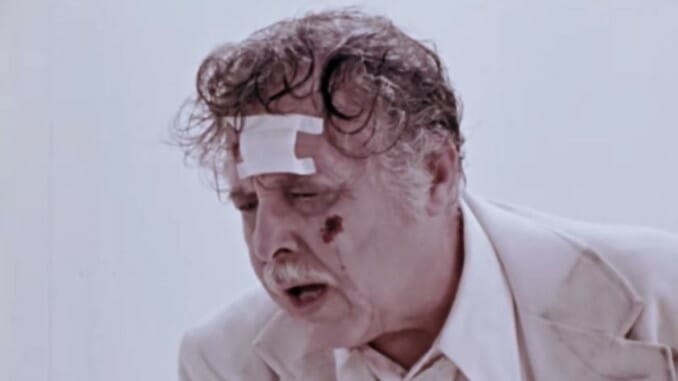George A. Romero’s The Amusement Park Is Mesmerizing, Experimental Horror
Photos via Shudder
It’s frankly difficult to imagine what exactly the Lutheran Society, of all organizations, could have been expecting in 1973 when they commissioned George A. Romero, the director of Night of the Living Dead, to shoot a film for them on the subject of elder abuse and ageism. Had any of those poor Lutherans seen the ghouls of Romero’s seminal zombie film, chewing on strips of human flesh or oozing blood from a fresh bullet hole in their skull? If they hadn’t seen his movies, then why would they hire him? And if they had, how could they not have expected the project to turn out as one that would be uniquely disturbing?
This is the core mystery that has always surrounded The Amusement Park, Romero’s infamous “lost” quasi-feature film, shot in 1973, the same year as the release of The Crazies and five years before Dawn of the Dead would cement his status as the nation’s most important and deeply influential horror auteur. No one can say what those Lutherans were thinking, but it seems clear that Romero’s results were not the educational PSA they were looking for. Instead, Romero ran with the themes of aging, mortality and ennui, crafting a bleak, disorienting film that projects the feel of a steadily mounting panic attack onto its audience. It’s easy to imagine the Lutherans taking one look at The Amusement Park and realizing that they’d made a grave mistake, even though the film ultimately accomplishes exactly what they’d asked. They wanted a piece of art that could make its audience ponder the fact that ignominious old age and death comes for us all, and that’s what Romero delivered. But The Amusement Park was stuffed away in a vault and left to rot for decades. And now, curious horror geeks can finally see it for themselves, as The Amusement Park hits horror streamer Shudder on June 8, 2021, some 48 years after it was filmed.
Let’s be honest, though: We ought to admit that the only reason there’s any interest in this 52 minutes of footage is due to the fact that Romero’s name is attached. This same allegorical, surreal piece of art rediscovered and proffered as a “lost classic” of some other, less influential director of the era would be roundly ignored by the vast majority of horror geeks and critics today for the fact that it’s not a true feature film, has limited commercial value, and is next to impossible to market on its own merits. As a lost piece of horror history from the father of the modern zombie genre, on the other hand, there’s enough built-in curiosity to both justify a release, and have The Amusement Park evaluated by critics under the most generous and forgiving of possible circumstances. There’s sure to be a big campaign among horror writers to anoint The Amusement Park as a magnum opus, out of fondness for the dearly departed director, and respect for his widow Suzanne Desrocher Romero, who helped to make the release possible. It won’t deserve some of these over-the-top plaudits.
The truth of the matter is that The Amusement Park is a strange, occasionally mesmerizing film that is not often pleasant to look at, but contains an air of nihilistic doom that is often effectively disturbing. One thing you can’t really call it is a proper narrative feature—we have a single protagonist of sorts wandering this amusement park, itself a rather heavy-handed, extended metaphor for life and society all rolled up into one, but there’s little dialog and almost nothing in the way of plot. This is an experimental art film, through and through—story is almost nonexistent, and largely inferred by an audience trained to assign story to the images we see. All The Amusement Park actually shows us is a man’s speedy descent into obsolescence and hopelessness as the world strips him of his dignity. What’s important is the sensations it manages to evoke in doing so.
Actor Lincoln Maazel plays the unnamed man who functions as The Amusement Park’s sole character, familiar to Romero fans as one of the stars of his 1978 psychological horror movie Martin. He introduces the movie here with a surprisingly sincere (and long) disclaimer about elder abuse and ageism, looking for all intents and purposes like a bewildered late career Orson Welles, albeit somewhat more engaging. The disclaimer makes one wonder if this was meant to be Romero’s way of living up to the expectations of those Lutherans, tacking on a more direct PSA on ageism before using the remainder of his runtime to dive deeper into the emotions connected with such abuse in a more oblique and evocative manner. Or in other words: “I got your moral out of the way; now I’m going to make this fever dream about a man losing his mind in an amusement park.”
-

-

-

-

-

-

-

-

-

-

-

-

-

-

-

-

-

-

-

-

-

-

-

-

-

-

-

-

-

-

-

-

-

-

-

-

-

-

-

-








































